You May Also Be Interested In:
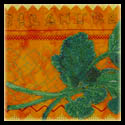 |
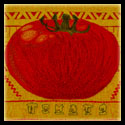 |
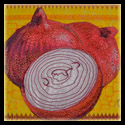 |
| Cilantro- Si! | 5 x 7 Week 3- The Start of Salsa |
La Cebolla (Onion) |
You May Also Be Interested In:
 |
 |
 |
| Cilantro- Si! | 5 x 7 Week 3- The Start of Salsa |
La Cebolla (Onion) |
We have some wonderful additions to the ongoing 5 x 7 Artist Challenge!
 |
| Fused Fabric Valentine by Janine |
Janine has a wonderful post on her Rainbow Hare blog called “Do You Ever Get Quilter’s Block?” Not only does she describe making this wonderful fused fabric Valentine, she also links up to a Ted Talk by Elizabeth Gilbert, the author of “Eat, Pray, Love.” What a wonderful opportunity to hear someone who has made such a success in her creative life struggle with many of the same challenges we all do. Thank-you, Janine, for sharing both your 5 x 7 pieces and Elizabeth Gilbert’s exposé on creative genius.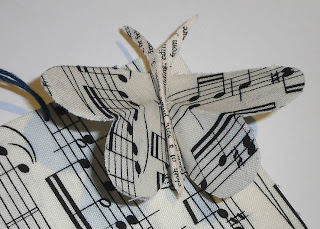 Detail of Rainbow Hare’s Fused Fabric Valentine
Detail of Rainbow Hare’s Fused Fabric Valentine
 Janine discusses her process for the little house piece to the left in her blog post “Not What I Meant At All”. I think it’s really helpful to hear how people start and what they go through to get to a finished result.
Janine discusses her process for the little house piece to the left in her blog post “Not What I Meant At All”. I think it’s really helpful to hear how people start and what they go through to get to a finished result.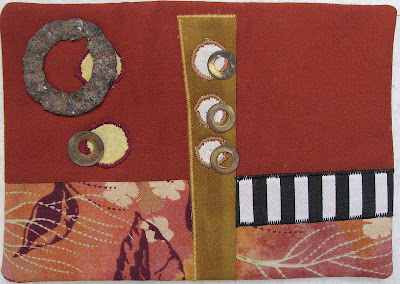 Next, Hilda of Hilda’s Hideout is working with found objects. Here are two of her newest pieces- I see a series in the making!
Next, Hilda of Hilda’s Hideout is working with found objects. Here are two of her newest pieces- I see a series in the making!
| Oak Tree in Fall by Lise- FrenchCanadian23 |
Although not yet complete, Lise has her second tree quilt well under way. I’m looking forward to seeing it when she finishes the thread painting that she’s planning.
You Might Also Be Interested In:
 |
 |
 |
| Developing the Creative Habit |
5 x 7 Artist Challenge |
Cilantro – Si! |
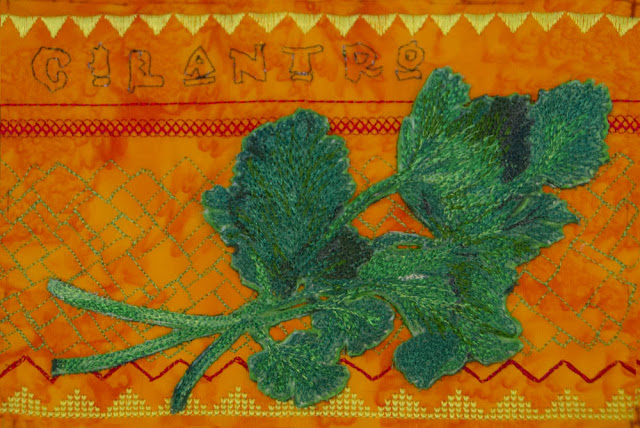 |
| “Cilantro” by Christina Fairley Erickson Freehand machine embroidery, decorative stitching and freemotion quilted |
 Since I already had the machine embroidered cilantro done, all I had to finish up was the background. For this, I started with stitching the name “Cilantro” as I had with my other Salsa pieces. To do this, I printed the word on a piece of paper-piecing paper in a funky font and then just stitched the letters out and tore away to paper. Then I chose a few different decorative stitches to start with.
Since I already had the machine embroidered cilantro done, all I had to finish up was the background. For this, I started with stitching the name “Cilantro” as I had with my other Salsa pieces. To do this, I printed the word on a piece of paper-piecing paper in a funky font and then just stitched the letters out and tore away to paper. Then I chose a few different decorative stitches to start with. |
| Cilantro freemotion quilting design |
Next, I wanted to fill the middle space with freemotion quilting. I drew out this design which I based on cilantro leaves. I like how it looks and was ready to try it out.
However, I then lay my machine embroidered Cilantro on top of the drawn design. I don’t think it was complementary at all! I’d like to try the leaf pattern somewhere, but this wasn’t the right place.
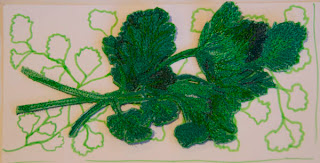 |
| Cilantro freemotion quilting design with cilantro machine embroidery on top |
 |
| Background getting filled in with cubing |
So, I decided to check my favorite resource, Leah Day’s FreeMotion Quilting Project, and thought that I could slightly modify her “Cubing” design. I worked the design at an angle or on-point, as well as putting in a lot of rectangular shapes, rather than mostly all squares.
After that, I only had to applique down my machine embroidery. Due to the thin stalks and ruffled edges of the cilantro, I decided to cut the embroidery along the edge, color in the edges and machine applique it (rather than hand-applique as I did on the others.) I did put a minimal amount of trapunto batting under a few leaves and left some of the edges loose, so it has a more 3-D effect.
You May Also Be Interested In:
 |
 |
 |
| Recognizing Our Limits and Not Giving Up |
A Sprig Away | La Cebolla (Onion) |
Also Check Out These Great Blogs!
 |
| “Forest” by Leslie Richmond Mixed fiber fabric, heat reactive base, metal patinas, acrylic paint, dyes |
 |
| “Forest” detail by Leslie Richmond |
Lesley Richmond of Vancouver B.C. created this fantastic piece of mixed fiber fabric, a heat reactive base, metal patinas, acrylic paint, and dyes. She starts with taking photos of trees, focusing on the branch structure. From there, she uses the images to make a silk screen and prints the trees on a silk-cotton fabric with a heat-reactive base. When heated, the heat-reactive base both expands and becomes dimensional.
 |
| “Forest” detail by Leslie Richmond |
She then removes the remaining cellulose/cotton fibers with a mild acid. What remains is the image and the silk-threads in the background. The final processes are stiffening the structures of the trees and painting them with acrylic paints and metallic patinas.
I think this piece may have been my favorite in the whole exhibition. I really recommend looking at Lesley’s website. Her work is exceptional!
 |
| “Forest” detail by Leslie Richmonds |
 |
| “Untitled” by Scott Fife Archival cardboard, drywall screws, and glue |
I had the pleasure of sitting next to one of the artists during the BAM High Fiber Diet Symposium, Scott Fife. Scott’s sculpture is large… life sized. Loving our Northwest beaches, it’s amazing to encounter a humongous piece of driftwood leaning up against the wall of a formal art museum.
Actually, this sculpture is probably 12-15 feet in height. It’s made from archival cardboard, drywall screws and glue. He chose to use cardboard as a way to honor and reclaim the product that originally came from a tree. Scott’s recent work is particularly interested in the mortality of trees.
For the last year, I’ve been learning to make driftwood sculpture. The type of sculpture I’m making is based of the Luron method… a way to take an interesting piece of driftwood (you need to choose a piece with interesting lines, curves, and grain) and the remove the outer dead layers of wood to find the inner heartwood.
Below the detailed images of Scott’s driftwood log are a few of the beautiful pieces made by members of the the Northwest Driftwood Artists (and two of my teachers).
 |
| “Untitled” detail by Scott Fife Tree knot |
 |
| “Untitled” detail by Scott Fife Tree knot |
 |
| “Tumbleweed” by Dave Sao |
 |
| “Wildfire” by Dave Sao |
 |
| “Emerging Swan” by Tuttie Peet |
 |
| “Safe Haven” by Jo Marsh |
You Might Also Be Interested In:
 |
 |
 |
| BAM High Fiber Diet | Beachpiration | Driftwood Art |
For great ideas on freemotion quilting, check out Leah Day’s FreeMotion Quilting Project
 |
| Dharma’s Retail Store in San Rafael, CA |
I’ve purchased many supplies at Dharma Trading Co. over the last few years. So, when I found out that Dharma has a retail store in San Rafael (about 45 minutes outside of San Francisco, where I’m visiting), I decided to make a trip. If you haven’t visited their website, they have almost anything and everything that you could need to dye, paint or do surface design on fabrics.
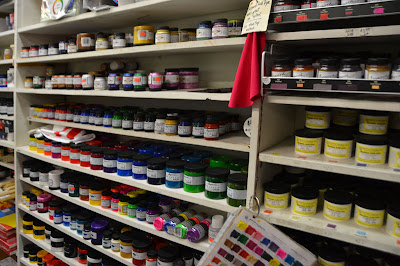 |
| Fabric Paints |
The one thing that you will find at Dharma’s retail store that they don’t have on their website is a wonderful wide supply of incredible yarns. While I’ve so far been able to restrain myself from catching the knitting and crocheting bug, I do still love beautiful yarn. I like couching yarns for different effects.
 |
| Dye Supplies |
You can also purchase both silk and cotton garments (generally in white, but also in black and a few in other colors) to use for dyeing and painting. The prices are very reasonable, which makes them great for resale after you surface design on them.
 |
| Shiva Oil Paintsticks, Rubbing Plates, and Metallic Pigments |
 |
| Fabric Dyes and Paints |
 |
| Dye-na-flow and Dyes |
 |
| Custom Yarns |
 |
| Custom Yarns |
 |
| Custom Yarns |
 |
| Custom Yarns |
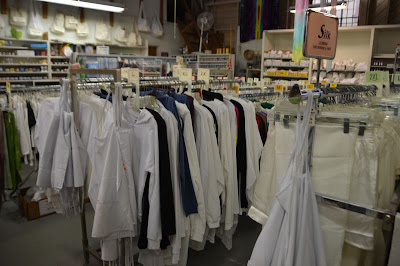 |
| Silk and Cotton garments that you can dye and paint |
 |
| Trees- 2 of my UFO’s that could use more paint and completion |
Now that I’ve seen all their wonderful products, I can’t wait to get back home to break out my dyes, paints and other supplies and finish up a few of my UFO’s, such as these trees. I have a few projects that I think that can be salvaged with a little overdyeing or adding some paint.
Hope you enjoy!
You Might Also Be Interested In:
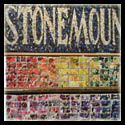 |
 |
 |
| Berkeley and San Francisco Fabric Excursion |
Recognizing Your Limits and Not Giving Up |
Developing the Creative Habit |
Check out Leah Day’s FreeMotion Quilting Project!
On the advice from my reader from Sophie Junction, today I went and visited StoneMountain and Daughter Fabrics, in Berkeley, CA. After 30 years, this store has a wonderful collection for quilters and seamstresses alike. They have one of the better collections of wool and linen I’ve seen (and I’ve looked for both in the Seattle area.)

 They also had some fabulous ethnic fabrics. The ceiling of StoneMountain has two wonderful long crazy quilt-like banners streaming across it, as well as fabulous quilts and an unusual kimono hanging from it.
They also had some fabulous ethnic fabrics. The ceiling of StoneMountain has two wonderful long crazy quilt-like banners streaming across it, as well as fabulous quilts and an unusual kimono hanging from it.

 After leaving Berkeley, we headed back to San Francisco,and visited an art supply & fabric shop in the Haight-Ashbury district called “Mendels & Far-Out Fabrics“. My girlfriend, Uvonne Jones-Most, is a painter, gourd artist, and glass maker. She referred me to Mendels, as a place to find unusual textiles, as well as incredible art supplies. Uvonne told me that Mendels stocks such unique products to appeal to the diverse population of San Francisco and the Haight neighborhood.
After leaving Berkeley, we headed back to San Francisco,and visited an art supply & fabric shop in the Haight-Ashbury district called “Mendels & Far-Out Fabrics“. My girlfriend, Uvonne Jones-Most, is a painter, gourd artist, and glass maker. She referred me to Mendels, as a place to find unusual textiles, as well as incredible art supplies. Uvonne told me that Mendels stocks such unique products to appeal to the diverse population of San Francisco and the Haight neighborhood.
 Well, she was right. Feathers, glitter, all sorts of sparkley fabrics, fake fur in every color, hand-made papers, and more.
Well, she was right. Feathers, glitter, all sorts of sparkley fabrics, fake fur in every color, hand-made papers, and more.
Stocked to the gills, it’s almost impossible to NOT find something that you’d like to play with!
I’m hoping to visit Dharma Trading Co. tomorrow, if I can fit it in with my family visits.
There are times for each of us when we need to just need to assess what’s realistic. It’s been that kind of week. As I mentioned a few days ago, I have a Valentines special trip to visit my girlfriend and her husband for their twenty-fifth anniversary. It turns out that Valentine’s and President’s day coincide with my sons’ mid-winter break, so my family and mother and I are taking a long weekend trip down to the San Francisco Bay area. But, as most of us know, things start to get complex as soon as you plan to get out of town.
 |
| My cilantro machine embroidery on the background fabric I’ve chosen (still to be completed.) |
Therefore, I haven’t finished my 5 x 7 art piece for the last week. I’m not sure whether I’ll get one done in the coming week, since I’m out of town. However, I did bring my sketchbook along, so perhaps I can finish something that way. My current 5 x 7, my cilantro piece, is well on it’s way. So, I might get it finished when I get back next Tuesday.
Regardless, I want to be honest with you… I think it’s important to recognize that we can’t always reach our goals. I’ve had a few people feel like they couldn’t continue with the 5 x 7 challenge, because things came up and they weren’t able to do their artwork a week or two. Sometimes the most important thing is to accept our failures and then get back to work. Perseverance pays. So even though I know last week and this coming one might not be as productive as I had hoped, I will not give up.
Here are a few more wonderful pieces from the Bellevue Art Museum “High Fiber Diet” exhibit:
 |
| “The Contact: Climax Forest” by Ann Johnston |
These three pieces by Ann Johnston were hung together and all feature Ann’s hand-dyed fabrics. Climax Forest is hand dyed cotton that has been hand & machine stitched. I love the complementary color scheme with the golden yellow-orange and blue.
 |
| “The Contact: Nevadan Orogeny” by Ann Johnston |
Her piece Nevadan Orogeny is also hand dyed cotton with machine stitching. It represents the era where massive plumes of molten magma intruded into the earth’s crust, lifting and creating the western part of the North American continent.
The final piece,Vigil is also hand dyed cotton with hand & machine stitching. I love the cracked look of the mountain peaks. I’ve climbed glaciers in Alaska and while the beauty of the great blue ice is incredible, something that many people don’t know is that the ices has cracks and lines of dirt, from the rocks that have been crushed through the force and power of the glacier.
 |
| “The Contact: Vigil” by Ann Johnston |
The next piece, “Studio” was constructed with Felt, Polyfiber, wire, and PVC. Tamara Wilson of Fairbanks AK recreates her surroundings with felt and thread. She feel that comfort and warmth, safety and security are conveyed both through the topic of her familiar surroundings as well as the usage of felt.
Each part of the scene below is made out of the felt and supporting pieces… and I mean every part of the scene… the bike on the wall, the light bulb and wire it hangs from, the table & chair, the sewing machine, reading glasses, cup of noodles, trashcan, etc. All of it!
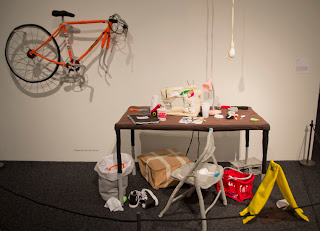 |
| “Studio” by Tamara Wilson |
 |
| “Studio” detail view |
I hope this gives you a little inspiration and helps you remember that it’s ok when you don’t always meet your goals. Goals are there to help you… to light your way. When you have other things in your life, it’s o.k. Learning balance is such a critical part of all of our lives.
You Might Also Be Interested In:
 |
 |
 |
| BAM High Fiber Diet | A Sprig Away | Developing the Creative Habit |
For great ideas on freemotion quilting, check out Leah Day’s FreeMotion Quilting Project
Today’s project has been working on a sprig of Cilantro for my Salsa quilt. This has been a little more challenging, as the uneven ruffled edges of the cilantro and the thin, fine stalks are going to make it pretty impossible to turn under the edges to applique. Unless you know a technique that I don’t!
 |
| “Cilantro” freehand machine embroidery by Christina Fairley Erickson |
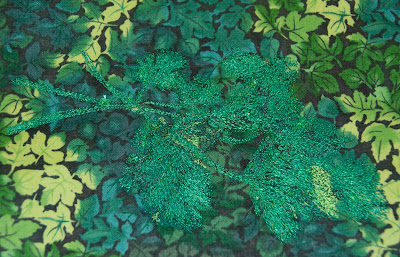 |
| “Cilantro” back |
So, I did this one a little differently, in that I decided to put a green, leafy background on the back, below the layers of stabilizer. This way, I can carefully cut around my machine embroidery and fasten it to the background, but allow some of the leaves to not be completely secured, and the backing fabric will show. I expect I’ll have to color along the edges where I cut, however.
I’m not quite sure what I’m going to do with the background this time around, though I’m considering putting it on either a red or yellow-orange piece. While I’m working on this little sprig, here’s something to think about on a much grander scale!
 |
| Sea Nettle” by Dina Barzel in foreground “Bridging Shine” by Jo Hamilton in background |
Yesterday, I started talking about the Bellevue Art Museum’s (BAM) current exhibit “High Fiber Diet.” One of the artists and a friend of mine, Dina Barzel, is an incredible woman in the fiber arts. Dina has been working as a full-time artist since 1970 and makes fiber sculptures. I met Dina through the Surface Design Association and am happy to have her join our monthly meetings here in Bellevue. Dina was born and grew up in the Western Carpathian Mountains of Transylvania. The traditional uses of fibers were an essential part of everyday life, and made quite an impression on her.
Dina’s sculpture for this show, “Sea Nettle” is made of silk fibers, shaped around molds. Some of the molds are large and light enough to even hold the artist! The silken globe rise up to the twenty foot ceiling, some partially open, as though they are allowing others to escape from within.
In the background, you’ll see an oversized male portrait called “Bridging Shine” by Jo Hamilton. This piece is made completely of mixed crocheted yarn and is about twice the size of life.
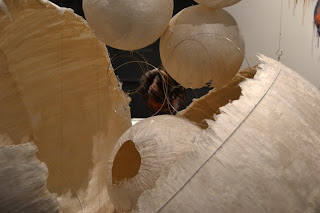 |
| “Sea Nettle” by Dina Brazel (detail) |
 |
| “Sea Nettle” by Dina Brazel (detail) |
You might also be interested in:
 |
 |
 |
| BAM High Fiber Diet | La Cebolla (Onion) | Developing the Creative Habit |
For wonderful Tutorials on FreeMotion Quilting and more, go to Leah Day’s FreeMotion Quilting Project
Today was all about the High Fiber Diet… and I’m not talking about food! Our local Bellevue Arts Museum or ‘BAM’ is currently hosting a Biennial exhibition which is featuring Fiber this year! BAM has considered one of its roles to include recognizing “the enduring and uninterrupted role of craft in shaping the aesthetic landscape of the region” (from the High Fiber Diet exhibit pamphlet.) Today they hosted an all day Symposium with incredible speakers and moderators which left me itching to come home and create! Since today was our normal day for our Contemporary QuiltArt Association meeting, we choose to meet at the symposium instead… which gave BAM a sold-out crowd!
 |
| “Oyster Light” by Barbara Lee Smith |
 |
| “Oyster Light” detail by Barbara Lee Smith |
One of the well-known moderators was Barbara Lee Smith, a resident of a small island in the Puget Sound. Barbara’s piece, “Oyster Light” is made from painted, collaged, and stitched synthetic fabric- a translucent, non-woven industrial fabric that looks like Japanese paper. Her sewing lines “echo the currents of sea and air, the topography of the earth, mapping the work with stitches that literally and figuratively finish it.”
 |
| Lorraine Barlow, Howard Barlow, Nate Steigenga, Jiseon Lee Isbara and Barbara Lee Smith (from left to right) at BAM Symposium 2/09/2013 |
Barbara moderated a talk called “Reinventing Tradition” with four of the other artists in the show. It was fascinating to hear the viewpoints and how tradition has influenced some very cutting-edge fiber artists.
 |
| “The Infallible Accounts of the Tilapia People and the Dead Which Soon Outnumbered Them: a Toile De Jouy” by Nate Steigenga |
One of the artists on the panel, Nate Steigenga, won the John and Joyce Price Award for Excellence for the BAM show, earning him his own solo show in the future. The fascinating thing about his piece is that it is reminiscent of a traditional quilt… sort of a tree of life feel, but when you get up close it’s much closer to something you’d see Hieronymus Bosch create with fabric! It’s actually a twist on Toile de Jouy, a type of fabric with an intricate scene printed on it. This artwork is made from bedsheets and pillow shams are backed with ironed-on drawer liners, which gives shade and depth to semi-transparent fabrics. Nate uses an exceptionally fine collage technique (many of his pieces are tooth-pick wide slivers.)
While I appreciate the process that went into the piece, as well as the black humor, I find it somewhat disturbing… I could stare at Barbara Lee Smith’s piece all day, but this left me somewhat disquieted. But perhaps that is the point.
 |
| Detail from Nate Steigenga’s artwork |
 |
| Detail from Nate Steigenga’s artwork |
There really is so much to say about all the pieces at this exhibition that it will probably take me many, many posts to share them all with you.
In a way, it was somewhat daunting. Here are “real” fiber artists… at least to this museum’s tastes. Art should be an expression of oneself and each piece in this exhibit is so different that it’s can be overwhelming. A few of the people discussed the sense of the the exhibit being “loud” since there is so much (44 artists… many with huge sculptural pieces) and that it isn’t a body of work that all goes together.
I found some of the work inspirational, some of it to be admired for technique, and some awe-inspiring for the scale or complexity which the artist achieved. But, most importantly, it was wonderful to be immersed in a community of artists with a “common thread” running through us all. Seeing all my CQA friends, meeting many of the artists with pieces in the show, it reminded me of how important it is to get out of the studio from time-to-time and see others who are involved in your genre of art.
I’ll post more photos from the exhibit soon.
You Might Also Be Interested In:
 |
 |
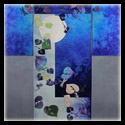 |
| Complex Threads 1 | Complex Threads 2 | Viewing for Inspiration |
 My dear friends are celebrating their Silver Wedding anniversary on Valentines day next week. As I was one of the bridesmaids in their wedding, I’m packing the family up and heading to visit them in San Francisco for the party. While I did live in the city for a short time, that was half a lifetime ago… so it’s hard to decide what all we will do while we’re there.
My dear friends are celebrating their Silver Wedding anniversary on Valentines day next week. As I was one of the bridesmaids in their wedding, I’m packing the family up and heading to visit them in San Francisco for the party. While I did live in the city for a short time, that was half a lifetime ago… so it’s hard to decide what all we will do while we’re there.
I’m looking now for a few good options on the fiber or quilt frontier in the Bay Area to explore. I was very sad to hear of Kasuri Dyeworks of Berkeley CA closing several years back. I still have some of the remarkable fabrics I purchased from them. I also just missed the Museum of Craft and Folk Art (SF) which closed at the end of 2012.
So here are some options I’ve found:
San Jose Museum of Quilts and Textiles This sounds like a good prospect, although the upcoming exhibits don’t really sound like they are totally up my alley.
The Lacis Museum of Lace and Textiles (Berkeley)
Art Fibers Fine Yarn (San Francisco)
Dharma Trading Company Store (San Rafael) This may be a bit too far, but I love buying my dyeing supplies from Dharma.
Anyone have experience with any of these places (positive or negative) or have a place in the San Francisco Bay Area that they’d highly recommend? I’d love some guidance and promise to share whatever I find!
This function has been disabled for Christina Fairley Erickson.
